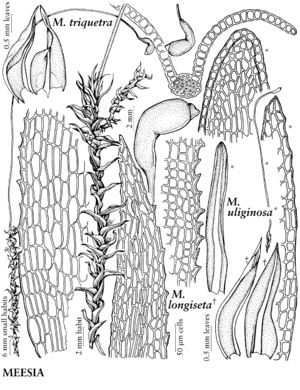Meesia longiseta
Sp. Musc. Frond., 173. 1801.
Plants 0.4–0.8 cm. Stem-leaves spreading and somewhat twisted when dry, irregularly spreading and indistinctly 3-ranked when moist, ovatelanceolate to lanceolate, 2–3.5 mm; base decurrent; margins plane to weakly reflexed basally, entire; apex acute to narrowly obtuse; costa narrow, ending in or just before apex; inner laminal cells smaller, walls thicker than those of marginal cells. Sexual condition synoicous. Seta 5–11 cm. Capsule 3.5–4.5 mm. Spores 36–44 µm.
Habitat: Calcareous soil banks, rich fens, boreal, alpine, and arctic habitats
Elevation: low to high elevations
Distribution

Alta., B.C., Man., Nfld. and Labr., N.W.T., Nunavut, Ont., Yukon, Alaska, Calif., Conn., Idaho, Ind., N.H., N.Y., Central America (Guatemala), Central America (Honduras), n Eurasia
Discussion
Meesia longiseta is distinguished from M. triquetra by its entire leaf margins, synoicous sexual condition, and generally more slender leaves. The species occurs in habitats similar to those of M. triquetra.
Selected References
None.
